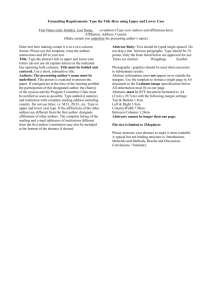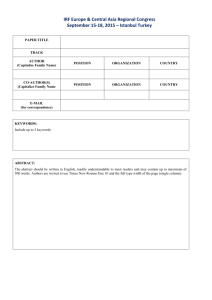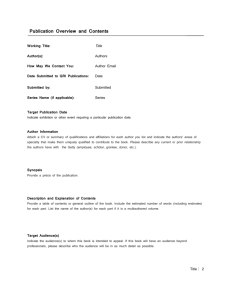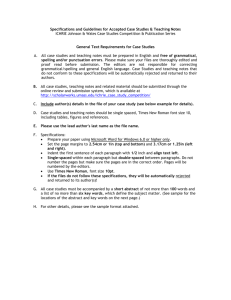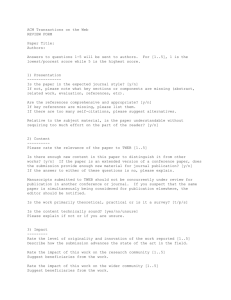Author Guidelines for the EAM 2003 Conference
advertisement
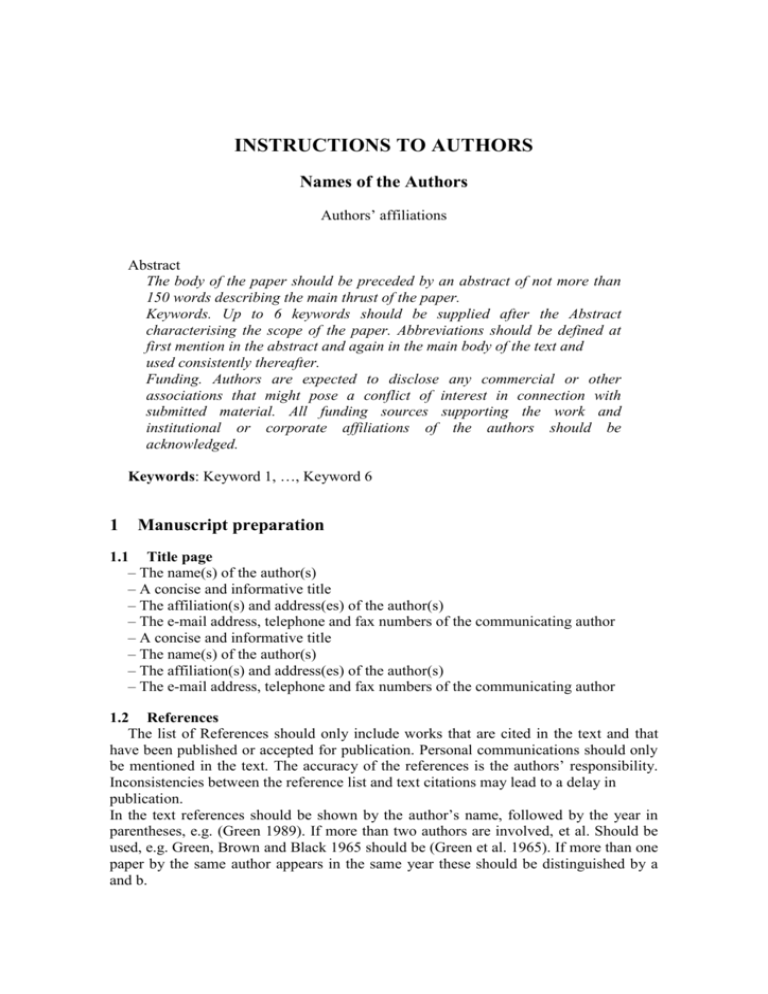
INSTRUCTIONS TO AUTHORS Names of the Authors Authors’ affiliations Abstract The body of the paper should be preceded by an abstract of not more than 150 words describing the main thrust of the paper. Keywords. Up to 6 keywords should be supplied after the Abstract characterising the scope of the paper. Abbreviations should be defined at first mention in the abstract and again in the main body of the text and used consistently thereafter. Funding. Authors are expected to disclose any commercial or other associations that might pose a conflict of interest in connection with submitted material. All funding sources supporting the work and institutional or corporate affiliations of the authors should be acknowledged. Keywords: Keyword 1, …, Keyword 6 1 Manuscript preparation 1.1 Title page – The name(s) of the author(s) – A concise and informative title – The affiliation(s) and address(es) of the author(s) – The e-mail address, telephone and fax numbers of the communicating author – A concise and informative title – The name(s) of the author(s) – The affiliation(s) and address(es) of the author(s) – The e-mail address, telephone and fax numbers of the communicating author 1.2 References The list of References should only include works that are cited in the text and that have been published or accepted for publication. Personal communications should only be mentioned in the text. The accuracy of the references is the authors’ responsibility. Inconsistencies between the reference list and text citations may lead to a delay in publication. In the text references should be shown by the author’s name, followed by the year in parentheses, e.g. (Green 1989). If more than two authors are involved, et al. Should be used, e.g. Green, Brown and Black 1965 should be (Green et al. 1965). If more than one paper by the same author appears in the same year these should be distinguished by a and b. At the end of the article, references should be given on a separate page in a list in alphabetical order in the following format: Chapter in a book: Parry GW (1994) Critique of current practice in the treatment of human interactions in probabilistic safety assessment. In Aldemir T et al. (eds). Reliability and safety assessment of dynamic process systems. Springer, Heidelberg, pp 156-165. Book: Cacciabue PC (1998) Modelling and simulation of human behaviour in system control. Springer, London. Journal Article: Adams M, Tenney Y, Pew R (1995) Situation awareness and the cognitive management of complex systems. Human Factors 37:85-104. References such as ‘‘personal communications’’ or ‘‘unpublished data’’ cannot be included in the reference list, but should be mentioned in the text in parentheses: this also applies to papers presented at meeting but not yet published or accepted for publication. A date should be given for both ‘‘personal communications’’ and ‘‘unpublished data’’. Papers which have been accepted for publication should be inlcuded in the list of references with the name of the journal and, ‘‘in press’’. Oral communications should only be mentioned in the acknowledgements. If available the Digital Object Identifier (DOI) of the cited literature should be added at the end of the reference in question. Example: Dyall KG (1998) Relative and non-relative finite nucleus optimized double zeta basis sets for the elements. Theor Chem Acc 99: 366-371 DOI 10.1007/s002149800025 1.3 Illustrations and Tables All figures (photographs, graphs or diagrams) and tables should be cited in the text, and each numbered consecutively throughout. Figure parts should be identified by lower-case roman letters. The placement of figures and tables should be indicated in the left margin. For submission of figures in electronic form see below. Line drawings. Please submit good-quality prints. The inscriptions should be clearly legible. Half-tone illustrations (black and white and colour). Please submit well-contrasted photographic prints with the top indicated on the back. Plates. Several figures or figure parts should be grouped in a plate on one page. Size of figures. The figures should either match the width of the column (80 mm) or be 110 mm. The maximum length is 230 mm. Figure legends must be brief, self-sufficient explanations of the illustrations. The legends should be placed at the end of the text. Tables should have a title and a legend explaining any abbreviation used in that table. Footnotes to tables should be indicated by superscript lower-case letters (or asterisks for significance values and other statistical data).

